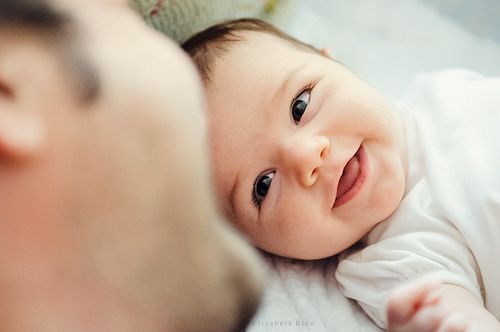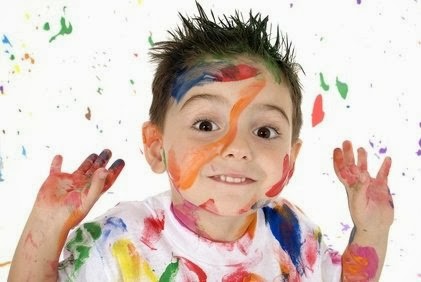When Babies Smile and Laugh: A Big Step In Their Emotional Development

When babies smile and laugh, it is a sign of their emotional development. Read along as we expand on this subject, starting from their first smiles till those that they share with us when they are older.
A baby’s first smiles
A one-month-old baby is not devoid of emotions as some may think. At this age a child is capable of feeling very strong attachment which is vital for their survival. In order to ensure their survival, they develop a strong attachment to an adult, who is usually their mother.
In addition to crying, which is the main emotion that babies portray, there are other emotions that a newborn can feel: well-being, relaxation, satisfaction… These feelings that are reflected when you see them being quiet, listening and observing as they learn about the world.
A newborn can also smile, but contrary to what it may seem, this smile is not a product of their emotional well-being or happiness; it happens due to the activity of their central nervous system. It is a reflex that appears usually when they are asleep.
Smiles after the first month
The smiles that a baby emits when awake after the first or second month, depending on the case, are known as social smiles. They are a result of interaction with the world and the response to diverse stimuli.
Babies start to understand that when their mother speaks to them, she smiles because she is happy. They also notice that other adults smile when they see them, play with or carry them. This is how they start to adopt smiling.
Therefore, babies smile when they feel good, are spoken to, given what they want or whenever they see or hear something that catches their attention in a positive way.

At this age, they start to understand that in addition to crying, their smiles also capture the attention of adults.
Some children let out their first laugh when they are 4 months old. Some start a little before, and others a little after. At this age the child starts to laugh when stimulated, just like adults. They do this when they find something funny: a doll that moves, when we tickle them…
After the age of 4 months, the child will not laugh or smile at everyone. They will only show these emotions with people they know or sometimes with strangers that they feel good around.
They start to understand that smiles are related to attachment and that they can smile to those they want to. This is known as the differential smile phase.
When babies smile and laugh: A breakthrough in their emotional development
As the child begins to understand the world, they start to imitate the people they live with. They learn to respond to stimuli and start to achieve advancement in their affective and psychosocial development.
A one-month old child learns that affection and social contact are reinforced with smiles. They learn that smiles are worth more than throwing tantrums and crying. As they grow, they start to understand that in order to get what they want – whether material or emotional – their smiles and laughter are useful tools.

The smiles of those around them also reinforce their emotions. If someone around them smiles, they will feel more secure. For example, if a dog passes on the sidewalk, they may feel afraid. Their mother’s smile can comfort them and indicate that there is no danger.
Laughter for a 2-year-old is no longer just a reflex or an exhibition of their happiness. It is a powerful tool that they use to achieve their goals and to make adults give in to their desires (emotional blackmail).
At this age we can observe the smart little one. They test those around them and act to see how others react. Whenever their mischief does not go well, they know that sketching a smile might mean evading punishment.
Laughter will also be stimuli for their emotional and cognitive development. They will laugh at absurd situations: When they see other children fall, or even when they watch themselves fall in a video that mom filmed.
Their laughter and smiles will help them grow as well as enhance their well-being and behavior as human beings. It will help them be more friendly, make more friends and feel happy.
All cited sources were thoroughly reviewed by our team to ensure their quality, reliability, currency, and validity. The bibliography of this article was considered reliable and of academic or scientific accuracy.
- Jeta, P. M. P. A. (1998). El desarrollo emocional infantil (0-6 años): Pautas de educación. In Ponencia presentada en el congreso de Madrid. España. http://www.waece.org/biblioteca/pdfs/d069.pdf
- Choca, F. (2007). VÍNCULO EN EL BEBÉ PREMATURO. Revista de APPIA-Octubre, (16), 56. https://www.bvspsi.org.uy/local/TextosCompletos/appia/079737212007001605.pdf
- Villanueva Suárez, C., & Sanz Rodríguez, L. J. (2009). Ansiedad de separación: delimitación conceptual, manifestaciones clínicas y estrategias de intervención. Pediatría Atención Primaria, 11(43), 457-469. http://scielo.isciii.es/scielo.php?script=sci_arttext&pid=s1139-76322009000400008
- Huerta, R. (2011). El juego simbólico. PULSO. Revista de Educación, (34), 227-230. https://revistas.cardenalcisneros.es/index.php/PULSO/article/view/122/98
This text is provided for informational purposes only and does not replace consultation with a professional. If in doubt, consult your specialist.








